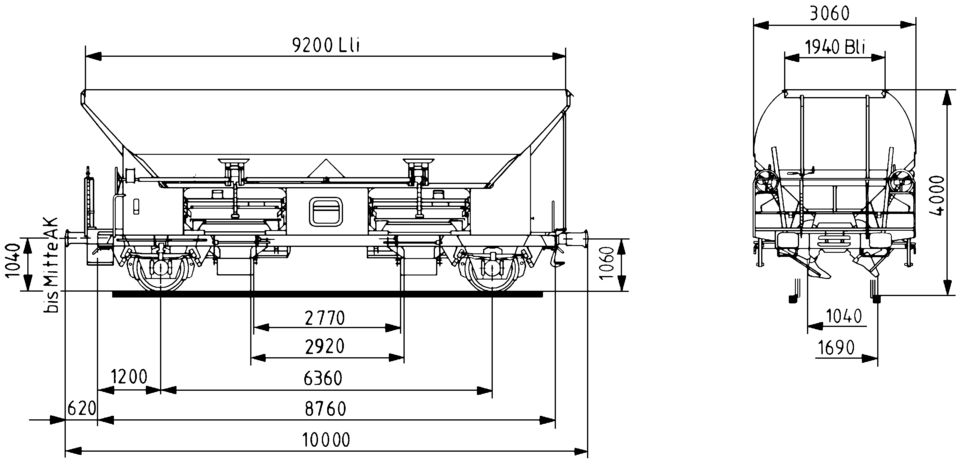Article: Fcns 091
Open bulk freight wagons with controlled gravity unloading and two wheelsets.Nothing left over: the loading space of open self-discharging wagons resembles a series of hoppers. The cargo is unloaded by gravity.
The wagons have several discharge openings each equipped with a rotary valve that enable the complete unloading of the wagon contents on either side of the wagon. The discharge rate is controllable, which is often required when unloading the goods onto a conveyor belt. The wagons are suitable for transporting bulk goods that do not need to be kept dry. The rotary valves can be operated individually using a device on the platform at one end face of the wagon.
Please note: Type is similar to the wagon in the photo. For exact dimensions, please refer to the drawing and the data below.
Technical details
Loading space (m3) | 45.0 |
Inside width of hopper (mm) | 1,940 |
Inside length of hopper (mm) | 9,200 |
Average tare weight (kg) | 13,500 |
Maximum speed (km/h) | 120 |
International usability | RIV |
Smallest radius of curvature (m) | 35 |
First year of delivery or year of construction of the oldest wagons at this time | 1988 |
Parking brake | With parking brake |
Brake type | KE-GP |
Number of brake cylinders (pcs.) | 1 |
Brake cylinder diameter (mm) | 300 |
Type of load-proportional braking | Two-stage, pneumatic, to be changed over manually |
Buffer type | UIC 526-1 |
Buffer head dimensions (mm) | 450 x 340 |
Automatic coupler | Prepared |
Distributor valve type | KE 2a/3.8 SL/D or KE 2adSL-D |
Individual data
Type of spring suspension | Double link |
Width of the fixed discharge chutes (mm) | 600 |
Width of the swivelling additional chutes (mm) | 750 |
Running gear as per drawing | 1Fwg091.1.02.000.001 |
Load limits
Average tare weight 13.5 t
With parking brake
A | B | C | D | |
|---|---|---|---|---|
S | 18.5 t | 22.5 t | 26.5 t | 31.5 t |
Additional information:
The wagon is suitable for transporting bulk goods of all kinds that do not need to be kept dry. The controllable discharge rate enables unloading onto conveyor belts. The swivelling discharge chutes allow the wagon to be used in underground bunkers located directly next to the track.
In accordance with the higher axle load (22.5 t), the load volume has also been increased to 45 m3 to better utilise the load limit even for cargo with a low apparent density.
The underframe is welded from rolled steel and folded sections. The material St 52 has been used for the underframe and the wagon body. The upper body edge, the entire discharge hopper, the rotary valves and the rotary valve seals are made of chrome steel 1.4003.
The side walls are inclined at 43°, the saddle and end walls at 48° to the horizontal. Two rotary valves are positioned in each side wall.
There are two rotary valves on each long side of the wagon, which can be opened or closed steplessly from the platform with a hand wheel. During unloading, the hand wheel does not need to be locked in any particular way, as the operating system is self-locking. The bottom edge of the fixed discharge chutes is 670 mm above top of rail when the wagon is empty. The bottom edge of the movable additional chutes is 390 mm above top of rail when swung out with the wagon empty.
Customs seal eyelets are located on each rotary valve and on the hand wheel for actuation of the rotary valves. A head plate and an adapter for attaching external vibrators for goods that are difficult to unload are fitted above each rotary valve.Cargo residues may only be removed from the loading or unloading lanes by lightlyknocking on the outer container walls with a rubber hammer or by using air blow lances in the loading space.
All data provided without any guarantee of correctness or completeness.
